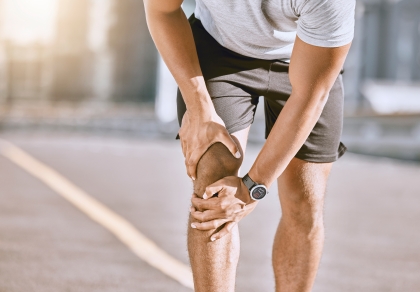Knee Pain in Men: Common Causes and Effective Treatments

Knee pain is common, especially in active men. It’s the joint that develops pain most commonly, with one-third of men experiencing significant knee pain in their lifetime.
Many factors can cause the knee to hurt, largely because the knee has lots of moving parts, any of which can develop a problem and produce pain. These parts can become inflamed from overuse, develop tears, wear out, fragment, or even break.
The knee consists of the end of the femur (thigh bone), which connects to the upper tibia (shin bone). Plus, there’s the patella (kneecap), the underside of which rubs on the end of the femur with bending and straightening. These bones are attached by a complex network of ligaments and tendons. The ends of the bones are coated in cartilage, which allows for smooth, pain-free motion of the knee. Between the femur and tibia, you’ll find the medial and lateral meniscus, which act as additional padding and stabilizers, unique to the knee.
The most common causes of knee pain are bursitis or tendonitis, which are conditions in which the tendon or bursa becomes inflamed. Tendons connect muscles to bone, while bursas cover tendons. They can become inflamed due to injury or overuse. Usually, these conditions respond well to rest, over the counter medicine like Tylenol and ibuprofen, and ice or heat.
Knee injuries resulting from slips, falls, twisting, or contact trauma can be painful because of tears to ligaments or tendons. Sometimes the forces through the knee are too much for these tissues, and they pop or tear. These injuries are often marked by sudden pain, swelling, or decreased mobility. These injuries can be treated without surgery and heal on their own in one to two months, though some tears need surgical repair to heal back.
The meniscus, which are disc-shaped pads nestled between the femur and the tibia, add cushioning and stability to the knee joint. No other joint has a meniscus! Sadly, the meniscus has a bad blood supply which can weaken over time. For patients over 30 years old, meniscus tears often occur without any sort of injury. Patients notice knee pain that develops suddenly, typically worsening with pivoting, squatting, or walking on uneven ground. Sometimes people experience “popping” or “locking”. Some patients with meniscus tears do well without surgery, but some request surgery for persistent symptoms.
Arthritis, a condition of deteriorating cartilage that coats the ends of our bones, can also affect the knee. As cartilage wears away due to wear and tear, age, prior injury, or genetic predisposition, the exposed bone of the femur rubs on the exposed bone of the tibia. This bone-on-bone contact is like the rim of the wheel of your car rubbing on the ground with no tire. It’s ugly, and in the knee, generates pain, inflammation, poor motion, limping. When mild, arthritis can be treated well with non-surgical means, such as medication, braces,
supplements, or injections. However, for more severe cases, surgery might be necessary and is usually effective.
To avoid knee pain, maintain normal body weight and try to avoid injury. We know that’s easier said than done, especially for active men working on uneven ground with slippery footing. Be careful.
For further questions, contact a health care provider who is experienced in treating knee pain.
